Synthesis and Characterization of Novel Fe-Mn-Ce Ternary Oxide–Biochar Composites as Highly Efficient Adsorbents for As(III) Removal from Aqueous Solutions
Abstract
:1. Introduction
2. Materials and Methods
2.1. Chemicals
2.2. Preparation of FMCBCs
2.3. Characterization of FMCBCs and BC
2.4. Adsorption Kinetics
2.5. Effect of pH and Ionic Strength
2.6. Reusability
2.7. Data Analysis
3. Results and Discussion
3.1. Physicochemical Properties of FMCBCs
3.2. As(III) Removal Efficiencies of FMCBCs
3.3. Adsorption Kinetics
3.4. Effect of pH and Ionic Strength on Adsorption
3.5. Stability and Reusability
4. Conclusions
Author Contributions
Funding
Conflicts of Interest
References
- Nabeel, K.N.; Irshad, B.; Muhammad, S.; Yong, S.O.; Edward, D.B.; Wang, H.; Shaheen, S.M.; Rinklebe, J.; Andreas, L. Arsenic removal by perilla leaf biochar in aqueous solutions and groundwater: An integrated spectroscopic and microscopic examination. Environ. Pollut. 2018, 232, 31–41. [Google Scholar]
- Han, H.; Hu, S.; Syed-Hassan, S.S.; Xiao, Y.; Wang, Y.; Xu, J.; Jiang, L.; Su, S.; Xiang, J. Effects of reaction conditions on the emission behaviors of arsenic, cadmium and lead during sewage sludgepyrolysis. Bioresour. Technol. 2017, 236, 138–145. [Google Scholar] [CrossRef] [PubMed]
- Zhu, N.Y.; Zhang, J.H.; Tang, J.; Zhu, Y.; Wu, Y. Arsenic removal by periphytic biofilm and its application combined with biochar. Bioresourc. Technol. 2018, 248, 49–55. [Google Scholar] [CrossRef] [PubMed]
- Beyki, M.H.; Alijani, H.; Fazlic, Y. Poly o-phenylenediamine-MgAl@CaFe2O4 nanohybrid for effective removing of lead(II), chromium(III) and anionic azo dye. Process Saf. Environ. Prot. 2016, 102, 687–699. [Google Scholar] [CrossRef]
- Luo, L.; Zhang, S.Z.; Ma, Y.B. Advance in Research on Arsenic Sorption and Its Affecting Factors in Soils. Soils 2008, 40, 351–359. (In Chinese) [Google Scholar]
- Hedrich, S.; Johnson, D.B. Remediation and selective recovery of metals fromacidic mine waters using novel modular bioreactors. Environ. Sci. Technol. 2014, 48, 12206–12212. [Google Scholar] [CrossRef]
- Pierre, L.P.; Fabienne, B.; Marc, P. Complete removal of arsenic and zinc from a heavily contaminated acid mine drainage via an indigenous SRB consortium. J. Hazard. Mater. 2017, 321, 764–772. [Google Scholar]
- Yoon, K.; Cho, D.W.; Tsang, D.C.W.; Bolan, N.; Rinklebe, J. Fabrication of engineered biochar from paper mill sludge and its application into removal of arsenic and cadmium in acidic water. Bioresour. Technol. 2017, 246, 69–75. [Google Scholar] [CrossRef]
- Niazi, N.K.; Bibi, I.; Shahid, M.; Ok, Y.S.; Shaheen, S.M.; Rinklebe, J.; Wang, H.L.; Murtaza, B.; Islam, E.; Nawaz, M.F.; Lüttge, A. Arsenic removal by Japanese oak wood biochar in aqueous solutions and well water: Investigating arsenic fate using integrated spectroscopic and microscopic techniques. Sci. Total Environ. 2018, 621, 1642–1651. [Google Scholar] [CrossRef]
- Mohamed, A.; Osman, T.A.; Toprak, M.S.; Muhammed, M.; Uheida, A. Surface functionalized composite nanofibers for efficient removal of arsenic from aqueous solutions. Chemosphere 2017, 180, 108–116. [Google Scholar] [CrossRef]
- Jiang, W.; Lv, J.; Luo, L. Arsenate and cadmium co-adsorption and co-precipitation on goethite. J. Hazard. Mater. 2013, 262, 55–63. [Google Scholar] [CrossRef] [PubMed] [Green Version]
- Ma, L.; Tu, S.X. Research status and prospect of remediation technology of arsenic-containing wastewater. Ind. Water Treat. 2009, 29, 1–6. [Google Scholar]
- Wu, S.L.; Deng, W. Research progress on treatment methods of arsenic-containing waste water. J. Guangxi Acad. Sci. 2011, 27, 172–174. (In Chinese) [Google Scholar]
- Li, G.; Sardar, K.; Muhammad, I.; Sun, T.R.; Tang, J.F.; Cotner, J.B.; Xu, Y.Y. Biochar induced modification of dissolved organic matter (DOM) in soil and its impact on mobility and bioaccumulation of arsenic and cadmium. J. Hazard. Mater. 2018, 348, 100–108. [Google Scholar] [CrossRef] [PubMed]
- Hua, M.; Zhang, S.J.; Pan, B.C.; Zhang, W.M.; Lv, L.; Zhang, Q.X. Heavy metal removal from water/wastewater by nanosized metal oxides: A review. J. Hazard. Mater. 2012, 211–212, 317–331. [Google Scholar] [CrossRef] [PubMed]
- Lin, L.N.; Qiu, W.W.; Wang, D.; Huang, Q.; Song, Z.G.; Chau, H.W. Arsenic removal in aqueous solution by a novel Fe-Mn modified biochar composite: Characterization and mechanism. Ecotoxicol. Environ. Saf. 2017, 144, 514–521. [Google Scholar] [CrossRef] [PubMed]
- Zhang, Y.; Yang, M.; Gao, Y.X.; Wang, F.; Huang, X. Preparation and mechanism of Fe-Ce Composites for Arsenic Removal from Groundwater. Sci. China 2003, 33, 127–133. (In Chinese) [Google Scholar]
- Ning, P. Research Progress of Rare Earth Adsorbents in Water Treatment. Chin. J. Rare Earths 2005, 23, 90–93. (In Chinese) [Google Scholar]
- Zheng, Q.; Lin, J.D.; Li, Q.R. Adsorption characteristics of arsenic in water by cerium oxide. Environ. Sanitatio Eng. 2008, 16, 13–16. (In Chinese) [Google Scholar]
- Keiluweit, M.; Nico, P.S.; Johnson, M.G.; Kleber, M. Dynamic Molecular Structure of Plant Biomass-Derived Black Carbon (Biochar). Environ. Sci. Technol. 2010, 44, 1247–1253. [Google Scholar] [CrossRef] [Green Version]
- Kumar, A.S.K.; Jiang, S.J. Chitosan-functionalized graphene oxide: A novel adsorbent an efficient adsorption of arsenic from aqueous solution. J. Environ. Chem. Eng. 2016, 4, 1698–1713. [Google Scholar] [CrossRef]
- Van Vinh, N.; Zafar, M.; Behera, S.; Park, H.S. Arsenic(III) removal from aqueous solution by raw and zinc-loaded pine cone biochar: Equilibrium, kinetics, and thermodynamics studies. Int. J. Environ. Sci. Technol. 2015, 12, 1283–1294. [Google Scholar] [CrossRef]
- Zhang, F.S.; Itoh, H. Iron oxide-loaded slag for arsenic removal from aqueous system. Chemosphere 2005, 60, 319–325. [Google Scholar] [CrossRef]
- Zhang, G.S.; Qu, J.H.; Liu, H.J.; Liu, R.P.; Wu, R.C. Preparation and evaluation of a novel Fe–Mn binary oxide adsorbent for effective arsenite removal. Water Res. 2007, 41, 1921–1928. [Google Scholar] [CrossRef] [Green Version]
- Li, P.; Jiang, E.Y.; Bai, H.L. Fabrication of ultrathin epitaxial γ-Fe2O3 films by reactive sputtering. J. Phys. D Appl. Phys. 2011, 44, 075003. [Google Scholar] [CrossRef]
- Zhang, Y.; Ying, M.; Dou, X.M.; He, H.; Wang, D.S. Arsenate Adsorption on an Fe−Ce Bimetal Oxide Adsorbent: Role of Surface Properties. Environ. Sci. Technol. 2005, 39, 7246–7253. [Google Scholar] [CrossRef] [PubMed]
- Beesley, L.; Moreno-Jimenez, E.; Gomez-Eyles, J.L. Effects of biochar and greenwaste compost amendments on mobility, bioavailability and toxicity of norganic and organic contaminants in a multi-element polluted soil. Environ. Pollut. 2010, 158, 2282–2287. [Google Scholar] [CrossRef] [PubMed]
- Cui, H.J.; Cai, J.K.; Zhao, H.; Yuan, B.L.; Ai, C.L.; Fu, M.L. Fabrication of magnetic porous Fe–Mn binary oxide nanowires with superior capability for removal of As(III) from water. J. Hazard. Mater. 2014, 279, 26–31. [Google Scholar] [CrossRef] [PubMed]
- Zhu, J. Adsorption behavior and mechanism of arsenic on graphene modified by iron-manganese binary oxide (FeMnOx/RGO) from aqueous solution. Ph.D. Thesis, Zhejiang University, Hangzhou, China, January 2016. (In Chinese). [Google Scholar]
- Lee, D.J.; Cheng, Y.L.; Wong, R.J.; Wang, X.D. Adsorption removal of natural organic matters in waters using biochar. Bioresourc. Technol. 2018, 260, 413–416. [Google Scholar] [CrossRef]
- Kolodyńska, D.; Wnetrzak, R.; Leahy, J.J. Kinetic and adsorptive characterization of biochar in metal ions removal. Chem. Eng. J. 2012, 197, 295–305. [Google Scholar] [CrossRef]
- Momčilović, M.; Purenović, M.; Bojić, A.; Zarubica, A.; Ranđelović, M. Removal of lead(II) ions from aqueous solutions by adsorption onto pine cone activated carbon. Desalination 2011, 276, 55–59. [Google Scholar] [CrossRef]
- Blázquez, G.; Martín-Lara, M.A.; Dionisio-Ruiz, E.; Tenorio, G.; Calero, M. Copper biosorption by pine cone shell and thermal decomposition study of the exhausted biosorbent. J. Ind. Eng. Chem. 2012, 18, 1741–1750. [Google Scholar] [CrossRef]
- Luo, C.; Tian, Z.; Yang, B.; Zhang, L.; Yan, S.Q. Manganese dioxide/iron oxide acid oxidized multi-walled carbon nanotube magnetic nanocomposite for enhanced hexavalent chromium removal. Chem. Eng. J. 2013, 234, 256–265. [Google Scholar] [CrossRef]
- Li, G.L.; Zhang, G.S.; Chen, J.; Ren, Z.M.; Chen, L.L. Preparation and characterization of phosphorus adsorption behavior of nanostructured magnetic particles of Fe3O4/Y2O3. J. Environ. Sci. 2012, 32, 2167–2175. [Google Scholar]
- Ho, Y.S.; Mckay, G. The kinetics of sorption of divalent metal ions onto sphagnum moss peat. Water Research. 2000, 34, 735–742. [Google Scholar] [CrossRef]
- Ho, Y.S. Citation review of Lagergren kinetic rate equation on adsorption reactions. Scientometrics 2004, 59, 171–177. [Google Scholar]
- Li, C. Research progress in heavy metal wastewater treatment with natural mineral materials. Technol. Dev. Chem. Ind. 2012, 26, 5–8. [Google Scholar]
- Mohan, D.; Sarswat, A.; Ok, Y.S.; Pittman, C.U. Organic and inorganic contaminants removal from water with biochar, a renewable, low cost and sustainable adsorbent—A critical review. Bioresourc. Technol. 2014, 160, 191–202. [Google Scholar] [CrossRef]
- Dou, X.M.; Zhang, Y.S.; Zhang, Y.; Zhao, L. Removal of As (V) from Fe(II)-Ce(IV) coprecipitation products in water. J. Saf. Environ. 2010, 10, 72–76. (In Chinses) [Google Scholar]
- Zhu, N.Y.; Yan, T.M.; Qiao, J.; Cao, H.L. Adsorption of arsenic, phosphorus and chromium by bismuth impregnated biochar: Adsorption mechanism and depleted adsorbent utilization. Chemosphere 2016, 164, 32–40. [Google Scholar] [CrossRef]
- Bakshi, S.; Banik, C.; Rathke, S.J.; Laird, D.A. Arsenic sorption on zero-valent iron-biochar complexes. Water Res. 2018, 137, 153–163. [Google Scholar] [CrossRef] [PubMed]
- Yu, Y.; Zhang, C.Y.; Yang, L.M.; Chen, J.P. Cerium oxide modified activated carbon as an efficient and effective adsorbent for rapid uptake of arsenate and arsenite: Material development and study of performance and mechanisms. Chem. Eng. J. 2017, 315, 630–638. [Google Scholar] [CrossRef]
- Zhang, L.F.; Zhu, T.Y.; Liu, X.; Zhang, W.Q. Simultaneous oxidation and adsorption of As(III) from water by cerium modified chitosan ultrafine nanobiosorbent. J. Hazard. Mater. 2016, 308, 1–10. [Google Scholar] [CrossRef] [PubMed]
- Siddiqui, S.I.; Chaudhry, S.A. A review on graphene oxide and its composites preparation and their use for the removal of As3+ and As5+ from water under the effect of various parameters: Application of isotherm, kinetic and thermodynamics. Process Saf. Environ. Prot. 2018, 119, 138–163. [Google Scholar] [CrossRef]
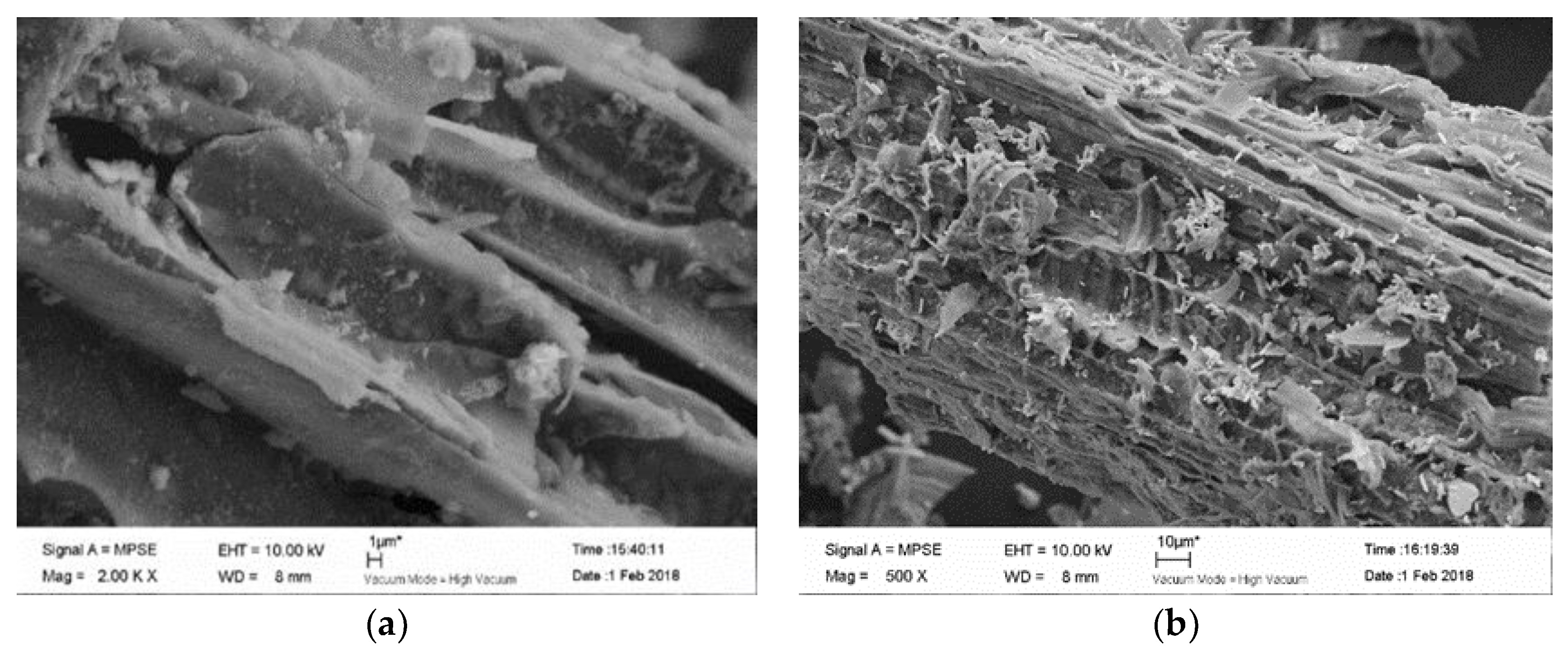
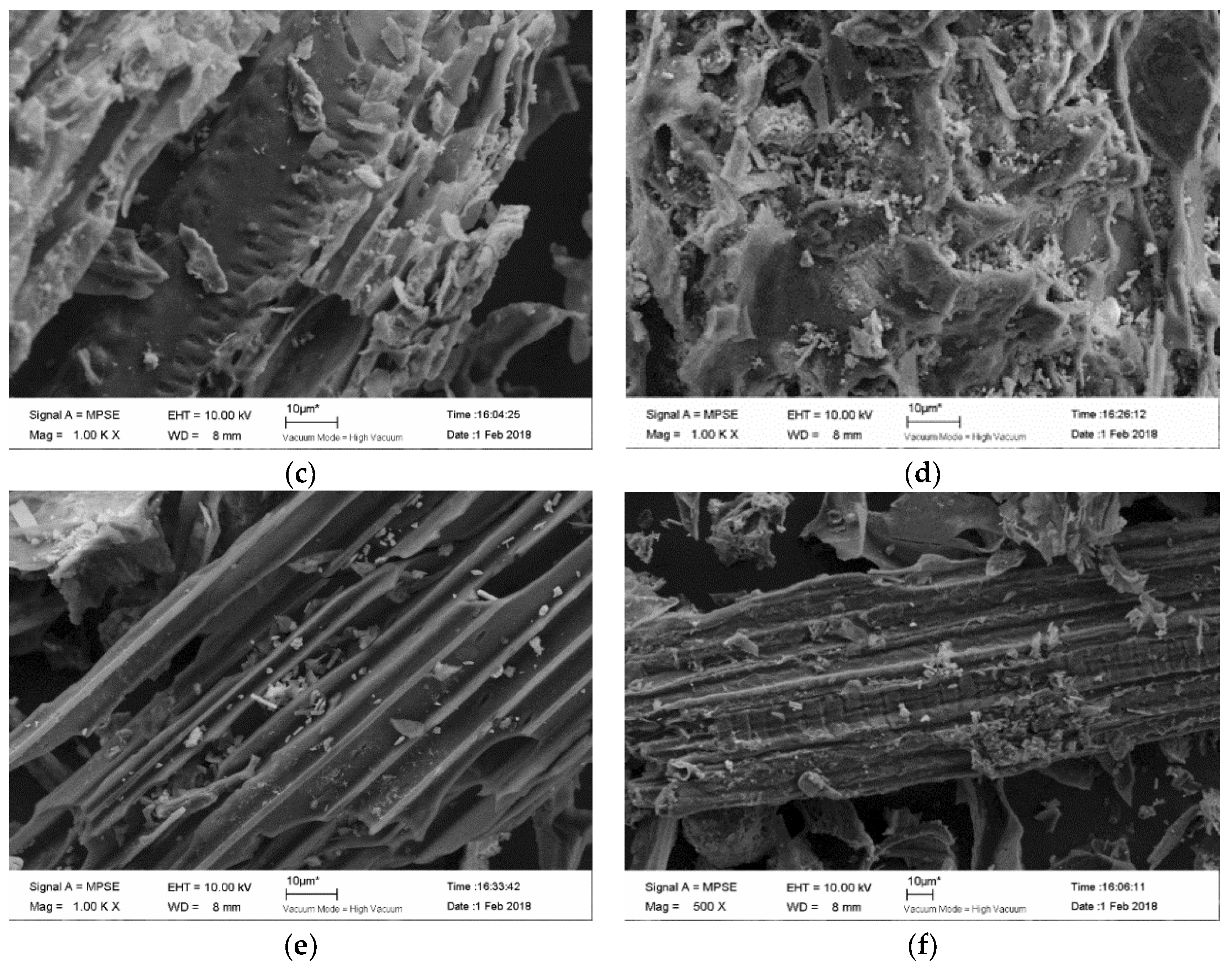
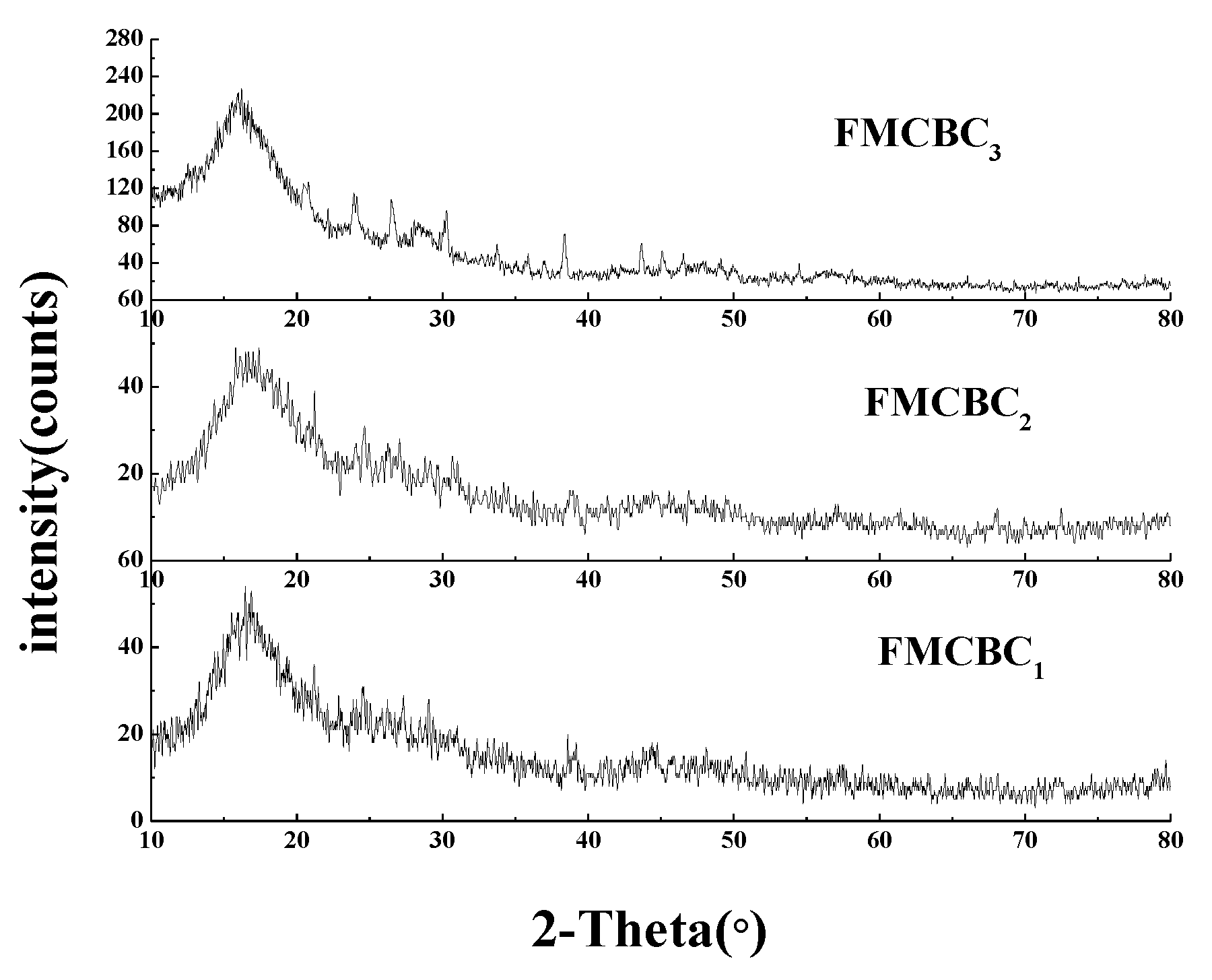
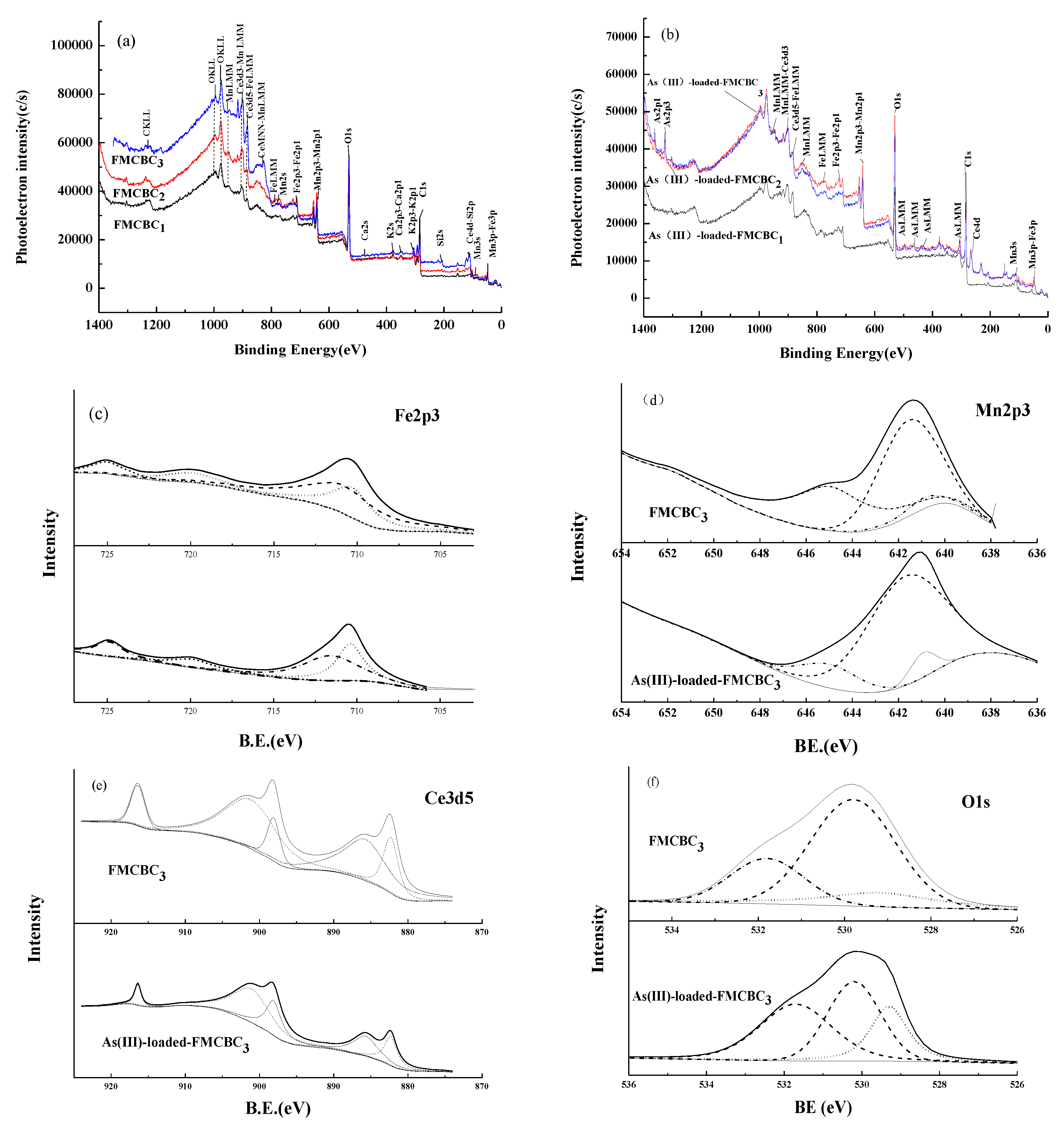


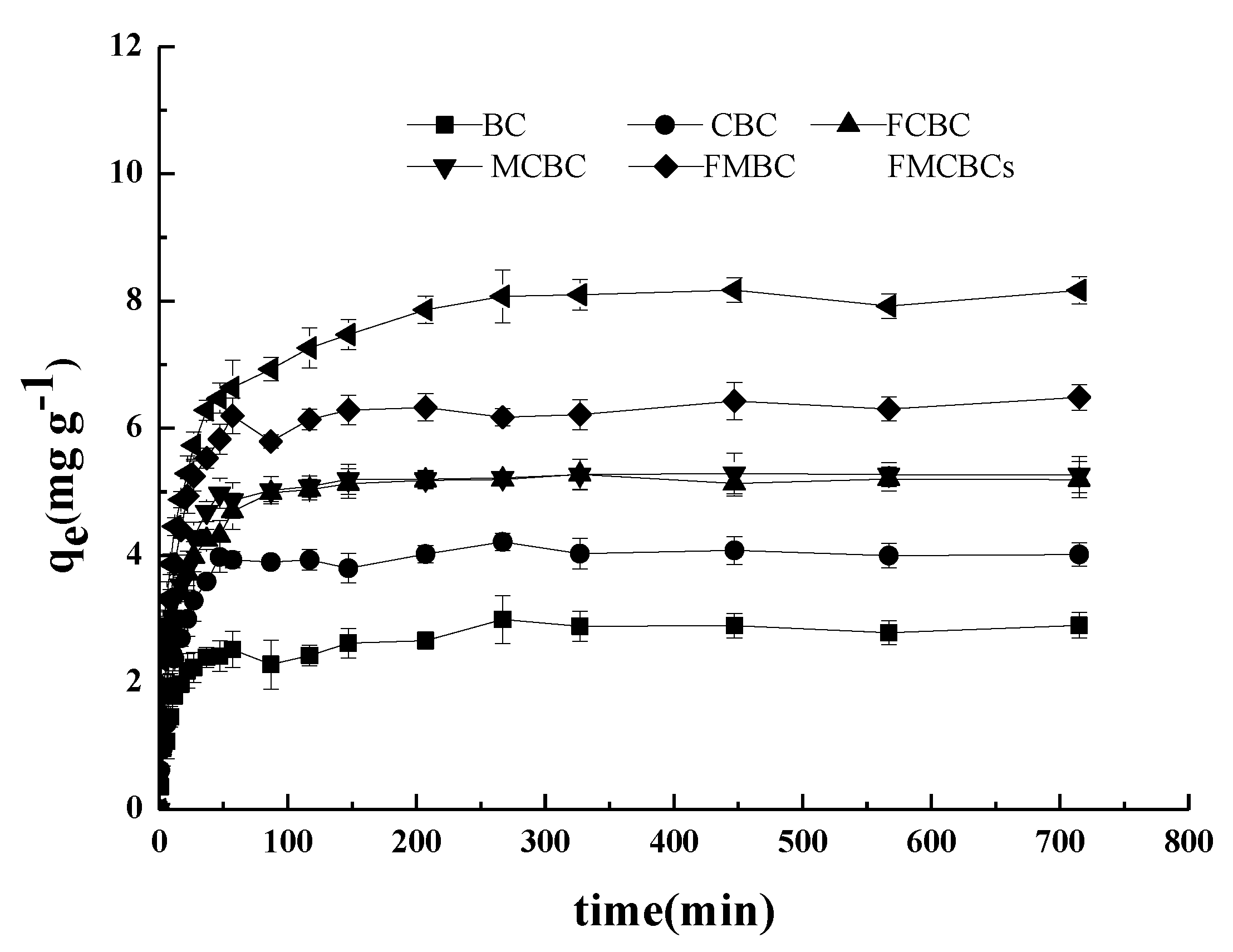


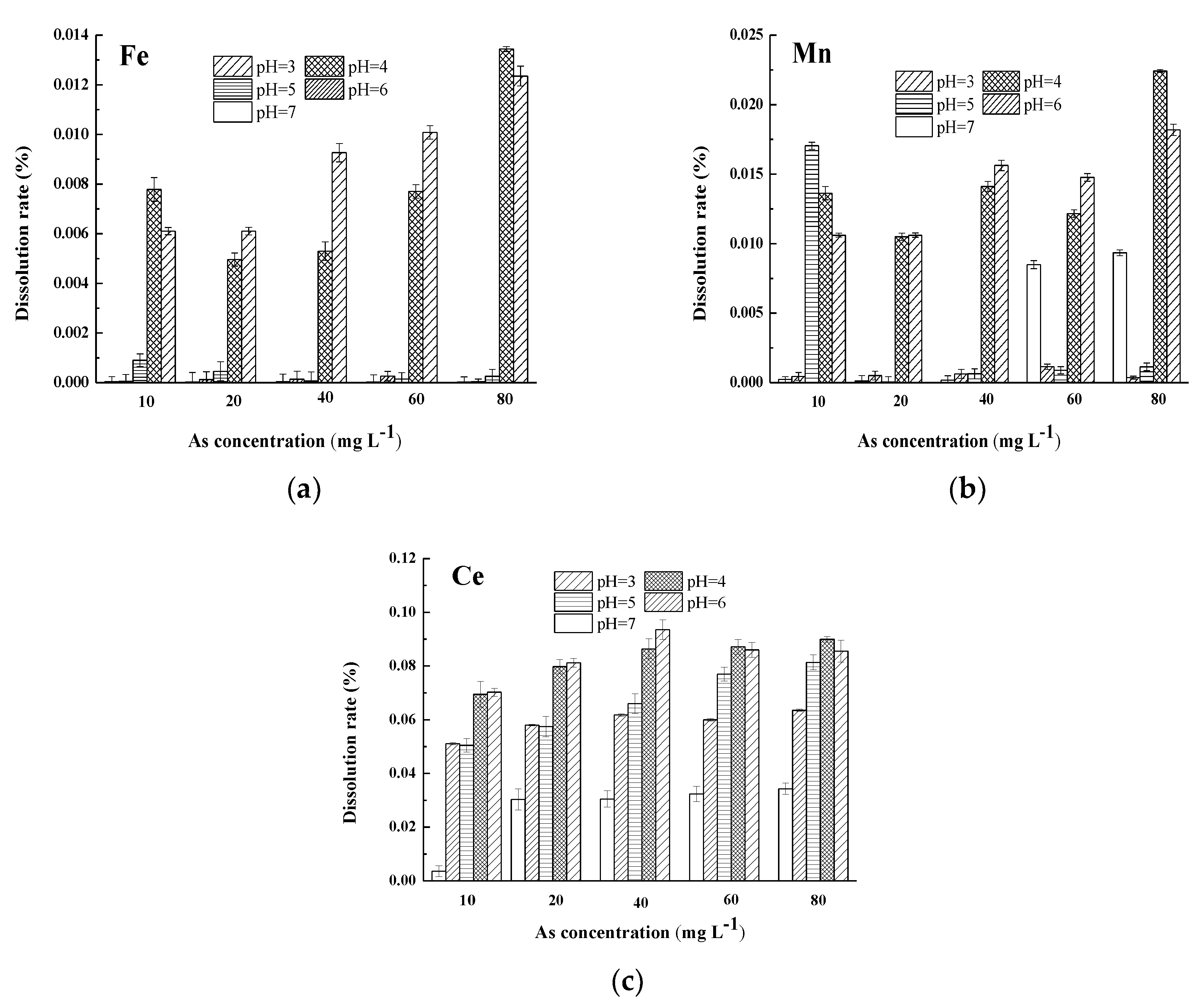
| Adsorbents | C (wt %) | N (wt %) | H (wt %) | Ash (wt %) | SBET (m2 g−1) | pH |
|---|---|---|---|---|---|---|
| BC | 85.26 | 0.81 | 5.20 | 10.17 | 60.9 | 8.93 |
| FMCBC1 | 62.31 | 1.67 | 2.56 | 30.57 | 26.33 | 9.39 |
| FMCBC2 | 53.34 | 1.71 | 2.47 | 30.66 | 35.74 | 9.61 |
| FMCBC3 | 42.13 | 1.73 | 2.21 | 32.6 | 46.66 | 9.64 |
| Adsorbents | C (wt %) | O (wt %) | Fe (wt %) | Mn (wt %) | Ce (wt %) | As (wt %) |
|---|---|---|---|---|---|---|
| BC | 75.01 | 15.3 | - | - | - | - |
| FMCBC1 | 60.04 | 33.7 | 1.2 | 7.44 | 0.64 | - |
| FMCBC2 | 52.78 | 36.69 | 1.12 | 7.41 | 1.40 | - |
| FMCBC3 | 38.82 | 48.94 | 1.17 | 8.72 | 1.90 | - |
| As(III)-loaded-FMCBC3 | 37.57 | 44.06 | 1.08 | 5.89 | 2.16 | 1.23 |
| Adsorbents | Pseudo First-Order | Pseudo Second-Order | ||||
|---|---|---|---|---|---|---|
| Qe (mg g−1) | K1 (min−1) | R2 | Qe (mg g−1) | K2 (mg−1 min−1) | R2 | |
| BC | 2.83 | 0.0401 | 0.985 | 2.84 | 0.0119 | 0.999 |
| CBC | 4.02 | 0.0876 | 0.758 | 4.01 | 0.0113 | 0.999 |
| FCBC | 5.16 | 0.0694 | 0.895 | 5.16 | 0.0113 | 0.999 |
| MCBC | 5.26 | 0.0601 | 0.931 | 5.27 | 0.0103 | 0.999 |
| FMBC | 6.40 | 0.0435 | 0.854 | 6.41 | 0.0044 | 0.998 |
| FMCBC | 8.47 | 0.0464 | 0.632 | 8.45 | 0.0028 | 0.998 |
| Cycle | Adsorbent (g) | As (mg/L) | Removal (wt %) | |
|---|---|---|---|---|
| Initial | Final | As | ||
| 1 | 0.1 | 20.00 | 0.64 | 96.8 |
| 2 | 20.00 | 1.27 | 93.6 | |
| 3 | 20.00 | 2.82 | 85.9 | |
| 4 | 20.00 | 4.13 | 79.4 | |
© 2018 by the authors. Licensee MDPI, Basel, Switzerland. This article is an open access article distributed under the terms and conditions of the Creative Commons Attribution (CC BY) license (http://creativecommons.org/licenses/by/4.0/).
Share and Cite
Liu, X.; Zhang, G.; Lin, L.; Khan, Z.H.; Qiu, W.; Song, Z. Synthesis and Characterization of Novel Fe-Mn-Ce Ternary Oxide–Biochar Composites as Highly Efficient Adsorbents for As(III) Removal from Aqueous Solutions. Materials 2018, 11, 2445. https://doi.org/10.3390/ma11122445
Liu X, Zhang G, Lin L, Khan ZH, Qiu W, Song Z. Synthesis and Characterization of Novel Fe-Mn-Ce Ternary Oxide–Biochar Composites as Highly Efficient Adsorbents for As(III) Removal from Aqueous Solutions. Materials. 2018; 11(12):2445. https://doi.org/10.3390/ma11122445
Chicago/Turabian StyleLiu, Xuewei, Guogang Zhang, Lina Lin, Zulqarnain Haider Khan, Weiwen Qiu, and Zhengguo Song. 2018. "Synthesis and Characterization of Novel Fe-Mn-Ce Ternary Oxide–Biochar Composites as Highly Efficient Adsorbents for As(III) Removal from Aqueous Solutions" Materials 11, no. 12: 2445. https://doi.org/10.3390/ma11122445





